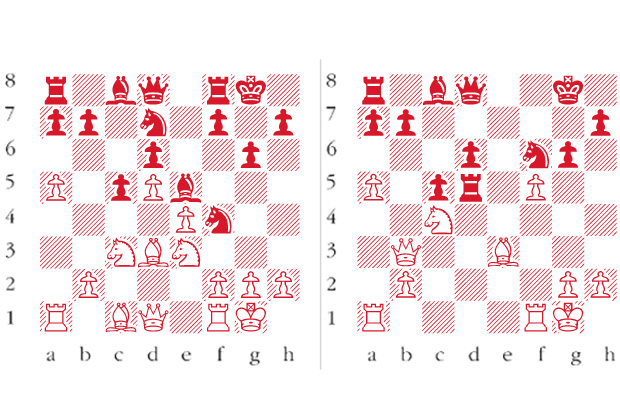The ever reliable Steve Giddins has just published a new book on that great strategist Aron Nimzowitsch. This is the third tome on Nimzo in the last few years, and in many ways it is the best. Giddins has overturned conventional thinking about Nimzowitsch’s celebrated games in the light of the latest computer analysis and investigations. In some cases the differences are quite astonishing, as in the following game from an elite event which earned Nimzowitsch a brilliancy prize. Notes based on those from Nimzowitsch: Move by Move (Everyman Chess).
Nimzowitsch-Marshall: New York 1927; Modern Benoni
1 c4 Nf6 2 d4 e6 3 Nf3 c5 4 d5 d6 5 Nc3 exd5 6 cxd5 g6 7 Nd2 Nbd7 8 Nc4 Nb6 9 e4 Bg7 10 Ne3 0-0 11 Bd3 Nh5 12 0-0 Be5 13 a4 Nf4 14 a5 Nd7 (see diagram 1) 15 Nc4 This position shows where the computer really can change assessments. The variation 15 Bc2 Qh4 16 g3 Qh3 17 gxf4 Bxf4 18 Ng4 Ne5! was previously assessed as ‘with complications not unfavourable to Black’. However, 40 years later and silicon-armoured, we can say that this is not the case: after the further moves 19 Nf6+ Kg7 20 Bxf4 Black is quite lost. 15 … Nxd3 16 Qxd3 f5 After 16 … Bd4 17 Bf4 Ne5 18 Bxe5 dxe5 19 Nb5 White has a slight advantage but the silicon beast points out something inconvenient for Black: instead of 17 Bf4, White has the much stronger 17 Bh6!, with the nasty point that after 17 … Re8 White really can take on d6: 18 Nxd6! Ne5 19 Qb5 and the knight is indirectly protected, thanks to the attack on the rook on e8!. 17 exf5 Rxf5 18 f4 18 Ne4 would, indeed, have retained the advantage, whereas after the text, things could have changed markedly. 18 … Bd4+ 19 Be3 Bxc3 20 Qxc3 Nf6 21 Qb3 Rxd5 22 f5 (see diagram 2) 22 … gxf5 This is the decisive mistake. Nimzowitsch does not even consider the other capture on f5, but after 22 … Bxf5 23 Bg5 Rd3 24 Qxb7 the position looks unpleasant for Black. However, once again, the computer refutes this with the incredible 24 … Be4! 25 Qa6 Qd7!!. Now after either capture on f6, the counterattack against g2 ensures Black enough play to draw: 26 Rxf6 (or 26 Bxf6 Qg4 with the same finish, whilst even 26 … Bxg2 leads to the same drawn result: 27 Kxg2 Qg4+ 28 Kh1 Qe4+, etc) 26 … Qg4 27 Rf2 Rd1+ 28 Rxd1 Qxd1+ 29 Rf1 Qe2 30 Rf2 Qd1+, and a draw. 23 Bg5 Rd4 Allowing a deadly discovered check, but there is nothing better. 23 … Be6 24 Qxb7 Rc8 25 Rae1 is lethal. 24 Nb6+ c4 25 Qc3 axb6 26 Qxd4 Kg7 27 Rae1 bxa5 28 Re8 Forcing mate. 28 … Qxe8 29 Qxf6+ Kg8 30 Bh6 Black resigns 30 … Qf7 31 Qd8+ mates.
This year the British Championship started early to permit the reigning champion, grandmaster David Howell, to travel to the Olympiad in Norway. The championship, which is being held in Aberystwyth, is nearing the halfway stage. After early rounds the leaders are Chris Ward, Jon Hawkins and Justin Tan.
Raymond Keene
Witsch craft

issue 26 July 2014




Comments